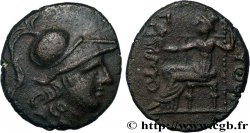v49_0143 - THRACE - THRACIAN ISLANDS - SAMOTHRACE Unité, (PB, Æ 18)
MONNAIES 49 (2011)
Starting price : 195.00 €
Estimate : 300.00 €
Realised price : 235.00 €
Number of bids : 2
Maximum bid : 268.00 €
Starting price : 195.00 €
Estimate : 300.00 €
Realised price : 235.00 €
Number of bids : 2
Maximum bid : 268.00 €
Type : Unité, (PB, Æ 18)
Date: c. 200 AC.
Mint name / Town : Thrace, Samothrace
Metal : copper
Diameter : 17,5 mm
Orientation dies : 3 h.
Weight : 5,09 g.
Rarity : R1
Coments on the condition:
Exemplaire sur un petit flan épais, bien centré des deux côtés, un peu court au revers sur les légendes. Très beau portrait d’Athéna. Revers de haut relief, bien venu à la frappe servi par une très jolie patine vert olive profond
Catalogue references :
Predigree :
Cet exemplaire provient du stock de Claude Silberstein (2003)
Obverse
Obverse legend : ANÉPIGRAPHE.
Obverse description : Buste d’Athéna (Minerve) casquée et drapée à droite, coiffée du casque corinthien.
Reverse
Reverse description : Cybèle (la Grande mère) tourélée, drapée assise à gauche, tenant une phiale (patère) de la main droite et un long sceptre de la main gauche.
Reverse legend : SA-M[O]/ PUQO[K].
Reverse translation : (Samos/ Pythok...).
Commentary
Sur notre exemplaire la fin du nom du magistrat n’est pas visible comme sur de nombreux exemplaires. C’est la première fois que nous présentons une pièce de Samothrace.








 Report a mistake
Report a mistake Print the page
Print the page Share my selection
Share my selection Ask a question
Ask a question Consign / sell
Consign / sell
 Full data
Full data